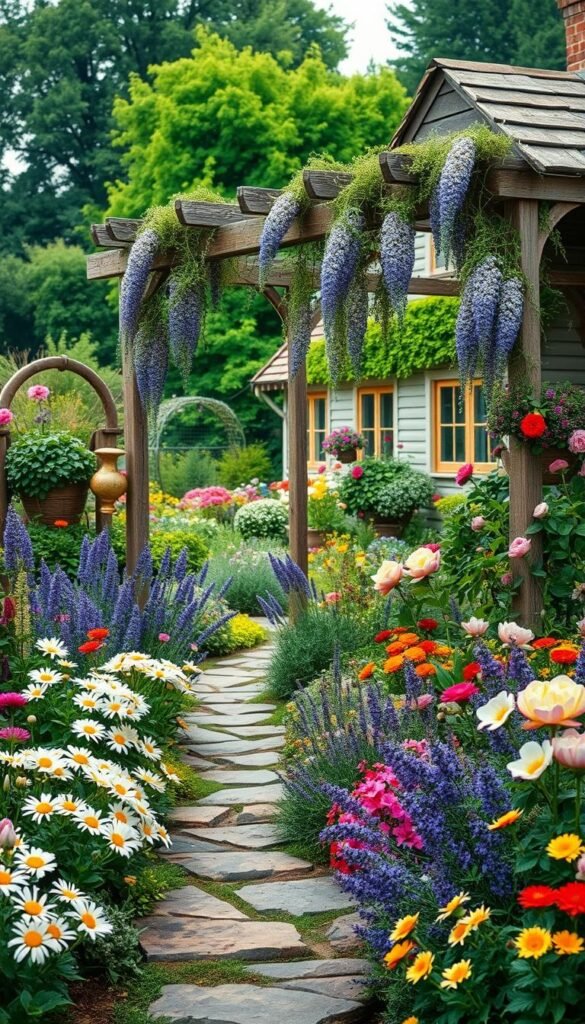Imagine stepping into a space where vibrant blooms mingle with fragrant herbs, and winding paths lead to cozy seating nooks. A cottage garden offers this magical blend of beauty and practicality, blending edible plants with ornamental flowers in a way that feels effortlessly charming. Unlike rigid formal landscapes, these gardens celebrate nature’s spontaneity while still feeling intentional.
You’ll find that every corner serves multiple purposes here. Medicinal plants like lavender grow beside cosmetic herbs such as Damask roses, while vegetables like cherry tomatoes invite impromptu snacking. This approach turns your outdoor area into both a sanctuary and a functional space, perfect for morning coffee or homemade herbal remedies.
What makes cottage gardens truly special is their ever-changing nature. Seasonal shifts bring new colors, textures, and scents to discover. You don’t need professional design skills – just a willingness to experiment with layered plantings and natural materials. Start with curved borders and mix tall hollyhocks with low-growing thyme for visual interest.
Your creativity becomes the driving force in crafting this living artwork. As plants mature and self-seed, the garden develops its own personality. Before long, you’ll have a thriving ecosystem that delights the senses year-round and reflects your unique style.
Embracing the Cottage Garden Aesthetic
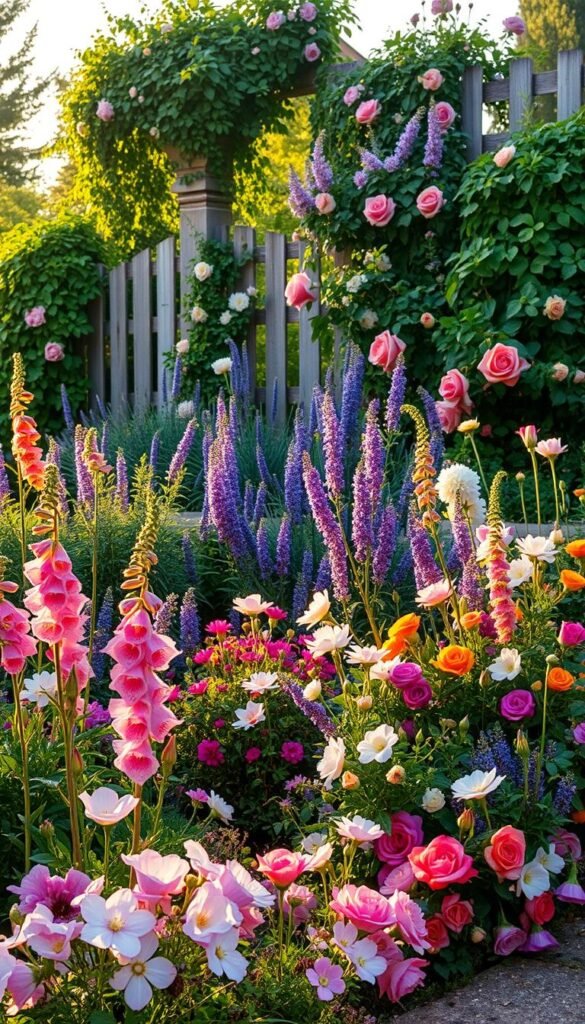
There’s something magical about a garden that feels both untamed and purposeful. Cottage gardens thrive on contrasts – soft curves instead of straight edges, fragrant herbs peeking through flowering vines, and colors that shift with the seasons. This style celebrates imperfection, inviting you to see beauty in nature’s spontaneous arrangements.
Defining the Whimsical Charm
Curved pathways and weathered wood fences set the stage for this playful aesthetic. Plants grow where they please – foxgloves tower over thyme, while nasturtiums spill onto stepping stones. This organized chaos creates surprises at every turn, like discovering mint volunteering beside your roses.
You’ll notice how textures matter as much as colors. Feathery ferns soften spiky lavender, and velvety rose petals contrast with crinkled sage leaves. These combinations engage your senses while supporting pollinators and beneficial insects.
Elements of a Traditional Cottage Garden
True to their roots, these spaces blend practicality with romance. Edibles like rosemary and calendula grow alongside peonies and delphiniums. A cottagecore aesthetic emerges through vintage tools repurposed as decor and arbors draped with climbing beans.
Layering plants creates depth and mystery. Tall hollyhocks form a living screen, mid-height daisies fill the middle ground, and creeping thyme carpets the soil. This approach maximizes space while mimicking nature’s layered ecosystems.
Laying the Foundation: Garden Layout and Design
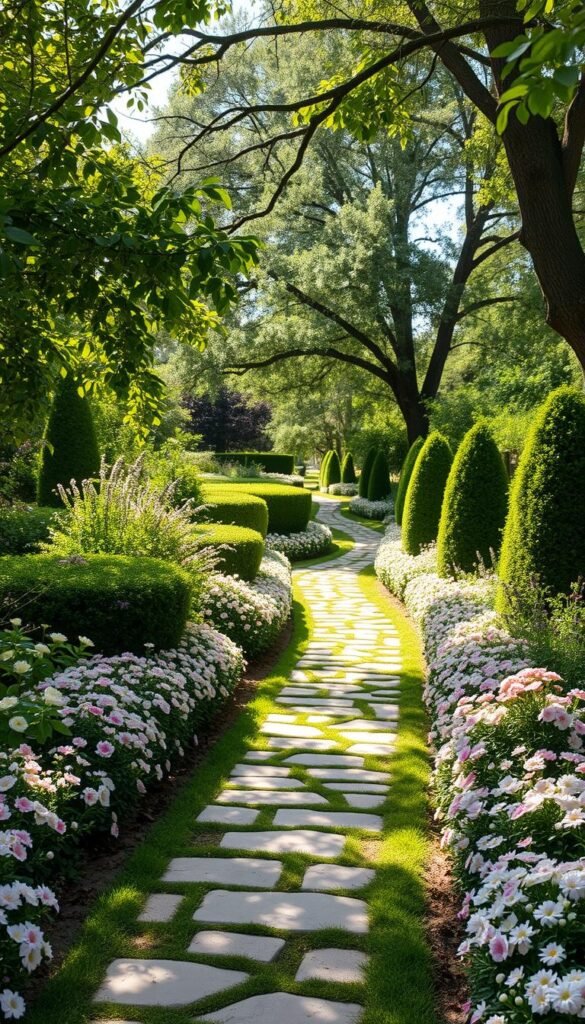
Creating a cottage garden begins with a dance between imagination and earth. Unlike structured landscapes, your design should feel like nature’s own blueprint – fluid lines guiding discovery while maximizing growing space. This approach lets every plant shine while maintaining that coveted “organized wildness” cottage gardens are known for.
Designing with Curved Lines and Natural Materials
Wave-like borders become your secret weapon. A meandering pathway of flagstone or gravel instantly softens rigid lines, inviting exploration. “Curves slow the eye and pace,” notes landscape designer Emma Brown, “creating intimacy with each planting bed.”
Sketching Your Garden Plan
Grab graph paper and trace your home’s outline. Draw a serpentine path hugging the structure, leaving 3-4 feet for planting beds. Use the smallest-to-tallest rule: edge walkways with creeping thyme (6″), flank with lavender (18″), then frame with hollyhocks (6′). This tiered approach ensures visibility while creating depth.
Selecting the Right Path and Plant Heights
Your pathway width matters more than you think. Keep it 24-36″ wide for comfortable strolling between bursting flower beds. Remember to account for mature plant sizes – peonies need 3′ spacing, while compact herbs like oregano thrive at 12″ intervals.
Natural materials like weathered bricks or bark mulch blend seamlessly with the aesthetic. These choices create harmony between your design and the surrounding environment, proving functional beauty requires no polish.
Selecting Plants and Flowers for Your Cottage Garden
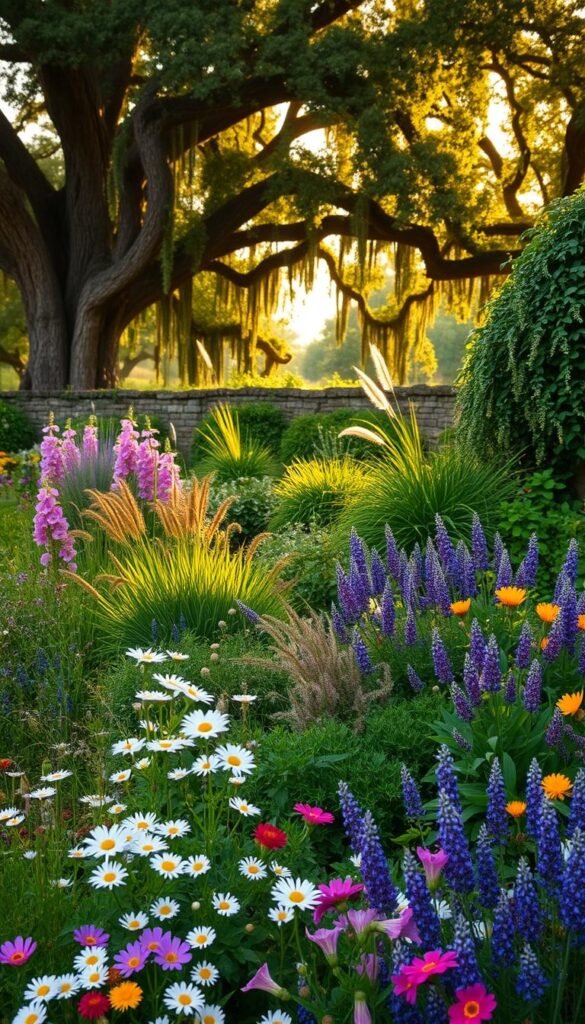
Your plant choices become the living palette that paints your cottage garden’s personality. Focus on varieties that offer staggered blooms, varied textures, and multiple seasons of interest. This ensures your space feels alive from spring’s first crocus to autumn’s golden chrysanthemums.
Perennials, Annuals, and Edibles
Start with reliable perennials like peonies and roses that form your garden’s backbone. These long-lasting plants return yearly, growing fuller with each season. Fill gaps with cheerful annuals like zinnias and cosmos – their bright flowers keep color constant while perennials establish.
Don’t forget edible herbs that pull double duty. Rosemary’s fragrant spikes complement lavender’s purple spires, while basil’s glossy leaves contrast with feathery dill. Many herbs thrive in patio containers if ground space is limited.
Creating Layered Planting Arrangements
Build height variations for visual drama. Place towering hollyhocks or sunflowers at the back, then mid-height daisies and poppies. Let creeping thyme spill over path edges. This structure creates depth while letting every plant shine.
Attract pollinators by mixing flower shapes – bell-shaped foxgloves, flat-faced daisies, and spiky salvia. These blooms become nature’s landing pads, turning your garden into a buzzing habitat. Remember: diversity prevents pests and keeps your ecosystem thriving.
Turning a Simple Flower Bed into a Cottage Flower Garden Paradise
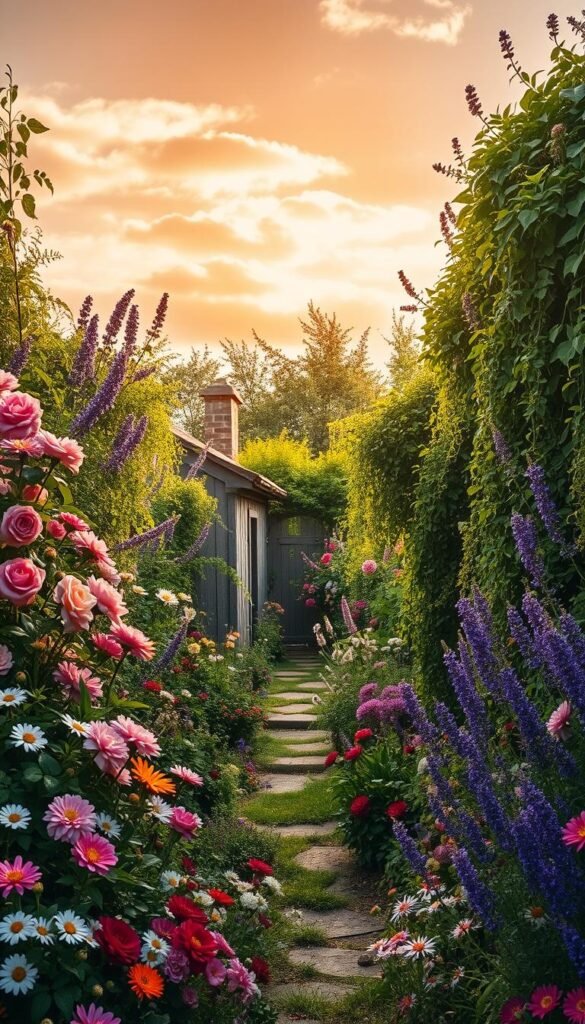
Ready to convert tired lawn areas into vibrant cottage gardens? The secret lies in smart layering and playful design. Begin by smothering grass using the lasagna method – alternating cardboard, compost, and straw to create nutrient-rich beds. This no-dig approach saves your back while building healthy soil ecosystems.
Step-by-Step Transformation Guide
Mark curved borders using garden hoses for natural-looking edges. Start planting with tall foxgloves at the back, then mid-height coneflowers, finishing with creeping phlox along pathways. This tiered approach ensures every plant gets sunlight while creating depth.
| Method | Time Required | Soil Improvement | Weed Control |
|---|---|---|---|
| Lasagna Layering | 4-6 months | High | Excellent |
| Traditional Digging | Immediate | Low | Moderate |
Incorporating Unique Design Elements
Add personality with repurposed items – turn old ladders into rose trellises or paint vintage buckets as quirky planters. Create focal points using stacked stone birdbaths topped with colorful saucers. These touches invite birds while adding visual interest.
Wind gravel paths through your beds, wide enough for comfortable strolls. Tuck ceramic statues among flowers for surprise discoveries. Finish with aromatic herbs like lemon balm near seating areas – their scent enhances relaxation in your new sanctuary.
Maintaining and Enhancing Your Cottage Garden Vibe
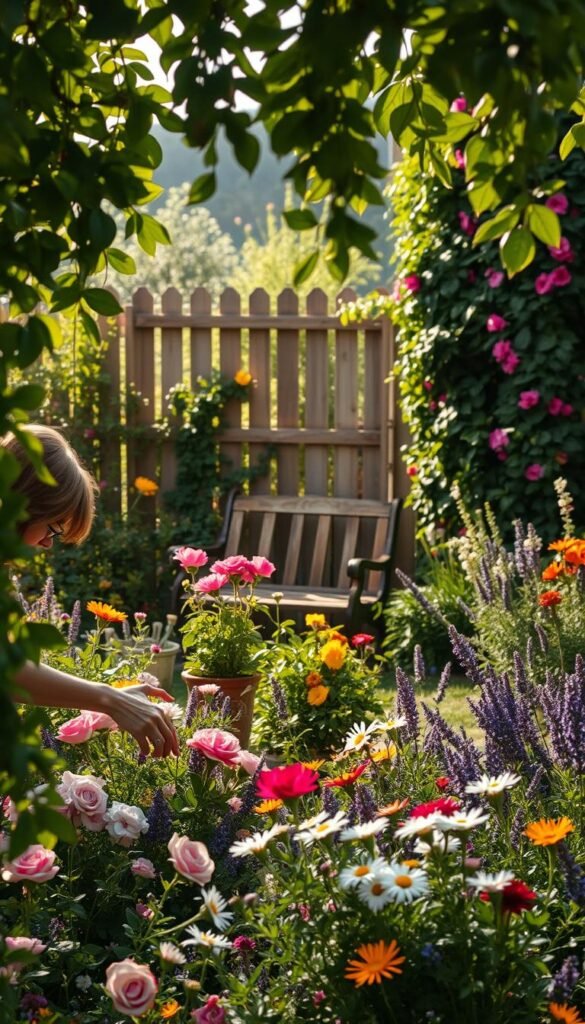
Your garden’s magic grows through thoughtful care and creative touches. Balance practical maintenance with whimsical upgrades to keep the space thriving and full of character.
Watering, Mulching, and Soil Care
Test soil pH annually – most cottage plants prefer 6.0-7.0. Enrich beds with compost each spring. Water deeply 2-3 times weekly, targeting roots instead of leaves. Container gardens might need daily drinks in summer.
Spread 3″ of mulch using shredded leaves or straw. This keeps soil moist, prevents weeds, and feeds earthworms. Refresh mulch every 6-8 weeks during active growth periods.
Seasonal Tips for Continuous Bloom
Deadhead spent flowers weekly to encourage new buds. Divide overcrowded perennials every 3 years. In fall, plant spring bulbs between existing plants for surprise color pops.
| Season | Key Tasks | Bloom Focus |
|---|---|---|
| Spring | Prune roses, sow annuals | Peonies, foxgloves |
| Summer | Water deeply, stake tall plants | Lavender, zinnias |
| Fall | Plant bulbs, collect seeds | Chrysanthemums, asters |
| Winter | Protect tender plants, plan layouts | Evergreen herbs |
DIY Upcycled Decor Ideas
Turn vintage colanders into hanging planters for strawberries. Paint old window frames as vertical herb gardens. Stack weathered books under a creative container garden display for height variation.
Use broken teacups as succulent holders along pathways. Attach mismatched silverware to stakes as plant markers. These projects add personality while reducing waste – perfect for cottage charm.
Bringing It All Together: Celebrate Your Garden Journey
Your cottage garden isn’t just a collection of plants – it’s a story written in petals and leaves. Each season adds new chapters as herbs spill over paths and flowers bloom in unexpected places. This living canvas grows richer with time, rewarding patience with bursts of color and fragrant surprises.
Feel pride in transforming ordinary space into a thriving habitat. Snip fresh basil for tonight’s dinner or arrange zinnias in a mason jar. These small joys become daily reminders of your creativity taking root. Share photos of your peonies’ first blush or that volunteer sunflower – your ideas might spark someone else’s dream plot.
Remember, perfection isn’t the goal. A weathered bench draped in climbing roses holds more charm than flawless beds. Let seedlings wander where they please, and embrace changes each year brings. Your garden’s true beauty lies in its ability to evolve, just like your skills as a grower.
As seasons turn, you’ll discover endless ways to play with textures and hues. Maybe next spring brings a new flower variety, or autumn invites rustic decor touches. This journey never truly ends – and that’s the magic of cultivating your own slice of earth.

